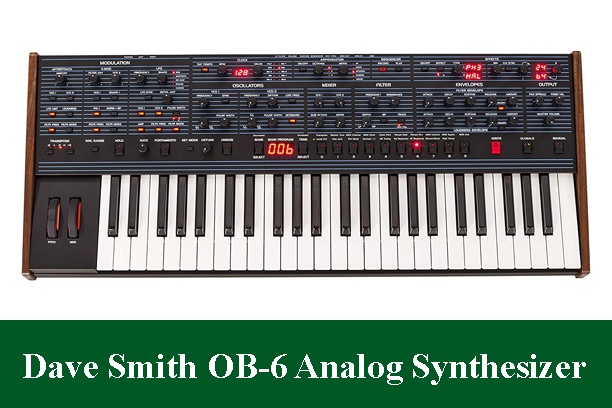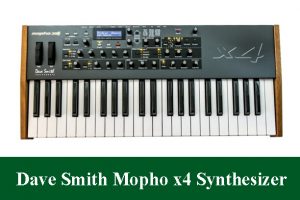Dave Smith Instruments OB-6 Analog Synthesizer Review (Updated)
The Dave Smith Instruments OB-6 is a synthesizer connoisseurs dream, a collaboration of two unbelievable names—Dave Smith and Tom Oberheim. Once equals, harking back to the 70’s when synths began going onto the scene, they have now united to deliver this monster of an instrument.
Many have run to the OB-6 since they value Oberheim’s capacity to make quality instruments, over the connection with Dave Smith.
Be that as it may, what makes the OB-6 uncommon? Also, does it truly pile planning some mischief like Dave Smith’s Prophet 6? These are the primary questions we will reply in this review, digging into striking features, sound quality, and significantly more.
Two Identical Faces
When you first methodology the OB-6 and the Prophet 6, they look indistinguishable. Both have wood boards and dark covered steel outsides. Both utilize a similar sort of handles and pitch wheels, just as having red LED lights to display what program you are as of now on. I like the red LED lights, as I think it is a lot less demanding to peruse than blue LEDs on some different instruments I have demoed.
My early introduction of the OB-6 is that it looks and feels exceptionally present day. The handles and the pitch wheels are smooth and feel high caliber. Be that as it may, the buttons themselves are somewhat of a mistake. They feel shoddy, for the most part since they are made of plastic. This is the place it sort of brings the keyboard brings me down from my underlying high of fervor.
When I went to touch the keys, I felt they too were somewhat shabby—however in any event they are not “squishy” and have truly great action. Originating from the universe of piano, I am accustomed to playing on completely weighted keybeds. The OB-6 has a semi-weighted keybed. While surely fine for what the OB-6 expects to give its clients, simply take note of that in case you’re a piano player going to the universe of synthesizers out of the blue, this conceivably may either turn you off at first, or require more time to conform to the keys’ touch and feel.
OB-6 & Prophet 06 Somewhat Similar
On the Dave Smith Instrument site, they set up together a PDF archive that puts the majority of their instruments next to each other spec-wise so you can perceive any striking contrasts. When you review this record, you will see how the Ob-6 and the Prophet 6 pile up likewise.
Here is a snappy rundown of a portion of the features they share:
- 6 voices
- 2 oscillators for every voice
- Double Digital Effects Processor
- 1 worldwide LFO
- 2 envelopes
- 64 stage polyphonic sequencer
- Arpeggiator
- 4 octaves, 49 keys
- Midi In, Out, Thru
- 1 continue
- 1 volume
- 1 LP channel cutoff
- 1 seq begin/stop
Like the Prophet-6, both of their waveforms consistently change. On oscillator 1, it moves between sawtooth to a heartbeat shape, while oscillator 2 can go from heartbeat, to sawtooth, to triangle. This gives it more space to adjust to various functions, not at all like different items that are increasingly static in nature.
The OB-6 additionally offers the Prophet’s arpeggiator. You have the option to choose rates between 30 to 250 bpm or execute synchronization with a MIDI planning clock. The Arpeggios can conceal to 3 octaves, with five options: up, down, up/down, arbitrary, and relegate. The last is made by the client when you discourage the keys you need to arpeggiate.
The arpeggiator has a hold option, which enables it to continue playing until it is discharged. You can likewise make increasingly complex examples with a feature called “relatching.” This enables you to hold one note from the first example while including additional notes.
Another comparative feature is their mutual sequencer. As mentioned in the above show, you have 64 stages to work with. Each progression can hold 6 notes, enabling you to hold harmonies and tunes. In the event that you fuse a footswitch to program rests ties, and furthermore transpose the current sequenced progression. While groupings are playing, you can likewise live play utilizing one of the free voices.
Tame Prophet & Fat Sound
Presently, when you put the OB-6 by the Prophet-6 on an intensifier to test their sound, you will see a noteworthy distinction. The Dave Smith OB-6 just sounds fatter and all the more full. It resembles a lion on a rope, trusting that the correct minute will break out of its limitations.
The Prophet-6, on the other hand, feels like the more established version of the OB-6 more pulled back, and putting more prominent accentuation on a tamer sound. It isn’t as tense yet maybe puts more noteworthy accentuation on making utilization of this more tightly control.
One point of contention that the synth network has contended over is its limitation of 4 octaves. Many would state this is adequate, while others may state this isn’t sufficient to make a piece with increasingly unique ranges in tone. Sitting at the value purpose of about $3,000 USD relying upon where you get it (and regardless of whether you can locate a quality one in utilized condition), it might be difficult to legitimize a buy. Particularly since you could locate a reasonable digital piano with incredible sounds for reduced cost. In any case, in the event that you need that vintage simple sound, you are unfortunately must pay for it.
In spite of the fact that I think the sound is magnificent on OB-6, there is one thing that I wish this synthesizer had that it doesn’t at present a LCD menu screen. You can spare patches you make with the OB-6 obviously, yet you can’t name them, and along these lines, it feels somewhat less natural. Being on the more costly side of things, I am astonished that a menu screen was not fused.
Different Points Of Contention
When delving into a portion of the worldwide features, alluding back to manual much of the time is an unquestionable requirement. This is another situation where a LCD screen would’ve been very useful, in spite of the fact that it merits nothing that the OB-6 and Prophet-6 likely don’t have screens since they were designed to be vintage simple synths (take the Oberheim OB-8, for instance).
Likewise worth nothing is that, sadly, you can’t run the arpeggiator and the sequencer in the meantime. This would have been an incredible feature to incorporate and would have offered significantly more potential outcomes for the client. Tragically, this is something that additionally brings down the instrument’s general rating. In spite of the fact that a minor hiccup, it could have been the what tops off an already good thing for a potential purchaser.
Another point where this instrument is missing is its failure for multitimbral operation. Obviously, this feature would have driven up the expense considerably more, however I think the cost increment would have been reasonable considering the majority of the potential outcomes that would have opened the client up to.
Conclusion
Each synth fan has a personal inclination regardless of whether they lean more towards Roland, Oberheim or other synth developers out there. For me, I have dependably been one-sided towards Roland, however that being stated, I truly do value the sound of the OB-6, particularly when in comparison to the Prophet-6. I think the sound is generally speaking better, and on the off chance that I needed to settle on a decision between the two, I would lean towards the OB-6.
It is elusive a shabby simple polysynth available, however I think you generally need to consider the sticker price and what the instrument offers. On account of the OB-6, while I do believe it’s an incredible instrument, I think whether you’re a person who feel the individual would be lost without a LCD screen, you should look somewhere else.
Generally, I think whether you can move beyond a portion of these little characteristics and present day predispositions, the sound of the OB-6 alone could make it worth your time and energy.



